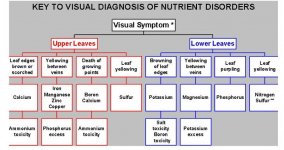hi! in advance I apologize for my English. I from Ukraine 
I ask to help to with my problems in a groving in coco. I grow mj about 7 years(last 4 years in a coco) and I have knowledge and experience in this technology of cultivation... the last 4 years of practice of cultivation in a coco I didn't have serious problems and only improved the equipment and increased yield. But the last half a year I have a similar problems with my plants.
now is more detailed...
these problems were shown on all my plants equally and order to death of a plant. At first there was a yellowness on leaves and subsequently a necrosis. Leaves disappeared beginning from below up and subsequently all plant dried up. I will reduce very probably on deficiency of phosphorus and at all plants the root system is badly developed, and roots have an unhealthy appearance.
I use such nutritious solution:
Mg(NO3)2 - 0,6 g\l
Ca(NO3)2 - 0,25 g\l
КН2РО4 - 0,4 g\l
«SoluPotasse» K2SO4 - 0,22 g\l
«BREXIL Combi» (cocktail micro EDTA) - 0,02 g\l
«Ferrilene» Fe-EDTA 11% - 0,01 g\l
«Brexil Ca» (EDTA) - 0,02 g\l
Ph= 5,8 ; 750ppm (cof0.5)
that gives us values in pure elements:
N 103,5
P 90,688
K 205,8234
Ca 49,335
Mg 54,27
S 40,5108
B 0,28
Fe 2,46
Mn 0,52
Zn 0,22
Cu 0,06
Mo 0,04
watering tried both manual hand watering and drip .





I ask to help to with my problems in a groving in coco. I grow mj about 7 years(last 4 years in a coco) and I have knowledge and experience in this technology of cultivation... the last 4 years of practice of cultivation in a coco I didn't have serious problems and only improved the equipment and increased yield. But the last half a year I have a similar problems with my plants.
now is more detailed...
these problems were shown on all my plants equally and order to death of a plant. At first there was a yellowness on leaves and subsequently a necrosis. Leaves disappeared beginning from below up and subsequently all plant dried up. I will reduce very probably on deficiency of phosphorus and at all plants the root system is badly developed, and roots have an unhealthy appearance.
I use such nutritious solution:
Mg(NO3)2 - 0,6 g\l
Ca(NO3)2 - 0,25 g\l
КН2РО4 - 0,4 g\l
«SoluPotasse» K2SO4 - 0,22 g\l
«BREXIL Combi» (cocktail micro EDTA) - 0,02 g\l
«Ferrilene» Fe-EDTA 11% - 0,01 g\l
«Brexil Ca» (EDTA) - 0,02 g\l
Ph= 5,8 ; 750ppm (cof0.5)
that gives us values in pure elements:
N 103,5
P 90,688
K 205,8234
Ca 49,335
Mg 54,27
S 40,5108
B 0,28
Fe 2,46
Mn 0,52
Zn 0,22
Cu 0,06
Mo 0,04
watering tried both manual hand watering and drip .


























 Do you mean balance of a anion\cations in solution? anion N+P+S = cations K+Ca+Mg
Do you mean balance of a anion\cations in solution? anion N+P+S = cations K+Ca+Mg
